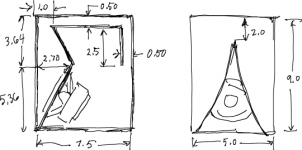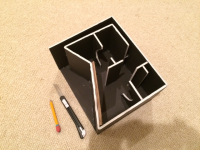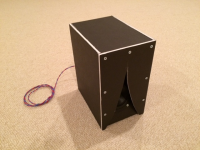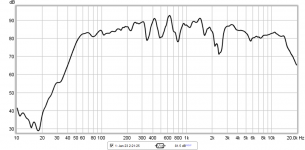haha - "barrel of fun" - - that's really cool - hey X - I'm hoping to get you in a mood to whittle some foam core klams - perhaps you can hit on the best proportions. Karlson used a 30 degree angle - Alan Weiss used close to 40 degrees which made it shorter
Bolexsbm - that's great stuff!!
first commercial klam - late 1950's I think (?)
jet engine nozzle

Carl klam for 5 inch Polk coax
AP9 ceiling speaker for 6x9" speaker
here's how one klam might be positioned (from AP9C brochure)
one of my custom klams - ~38 degree coupler, 15 inch Eminence coax - here with
an extended K-tube shoved down its throat. This increases the HF dispersion and since
the HF exit is close to the main aperture, there's less "reverb"
Carl's klam10 for Eminence B102, Beta10cx, etc. - a great size
rough description of Carl's klam 10 dimensions - these need to be double checked
you want the radial arc aperture to open up near full width - my previous builder went by a dimension
and the aperture ended up too choked
Bolexsbm - that's great stuff!!
first commercial klam - late 1950's I think (?)
An externally hosted image should be here but it was not working when we last tested it.
An externally hosted image should be here but it was not working when we last tested it.
An externally hosted image should be here but it was not working when we last tested it.
jet engine nozzle

Carl klam for 5 inch Polk coax
An externally hosted image should be here but it was not working when we last tested it.
AP9 ceiling speaker for 6x9" speaker
An externally hosted image should be here but it was not working when we last tested it.
An externally hosted image should be here but it was not working when we last tested it.
here's how one klam might be positioned (from AP9C brochure)
An externally hosted image should be here but it was not working when we last tested it.
one of my custom klams - ~38 degree coupler, 15 inch Eminence coax - here with
an extended K-tube shoved down its throat. This increases the HF dispersion and since
the HF exit is close to the main aperture, there's less "reverb"
An externally hosted image should be here but it was not working when we last tested it.
Carl's klam10 for Eminence B102, Beta10cx, etc. - a great size
An externally hosted image should be here but it was not working when we last tested it.
rough description of Carl's klam 10 dimensions - these need to be double checked
you want the radial arc aperture to open up near full width - my previous builder went by a dimension
and the aperture ended up too choked
An externally hosted image should be here but it was not working when we last tested it.
Last edited:
what should one expect for changes in coverage patterns and angles as a klam's coupler angle is raised from 25 degrees relative to ground to a steeper 40 degrees?
Kalrson-Oliver Phase III

klam8 ~ like the Weiss Patio speaker
Kalrson-Oliver Phase III

klam8 ~ like the Weiss Patio speaker
An externally hosted image should be here but it was not working when we last tested it.
Last edited:
Klam with Hypercube and RS100-4
Ok Freddi, I built a foam core Klam!
To save time, I tacked it onto an existing Hypercube for the rear sealed chamber. I sort of guessed dimensions and set it based on the Hypercube edge face which is 4.75in wide. So the Klam is 4.75in wide x 4.75in tall x 8.5in long. There is a 0.5in gap at the end of the Klam where the opening is widest. I used CLD on the main flat panel to reduce vibrations and harmonic distortion. I hot melt glued the Klam onto the Hypercube.
Here are some photos of the little Klam, ain't it cute?
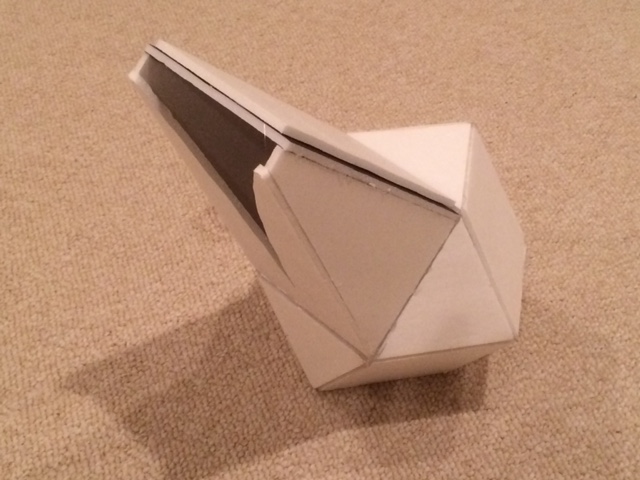
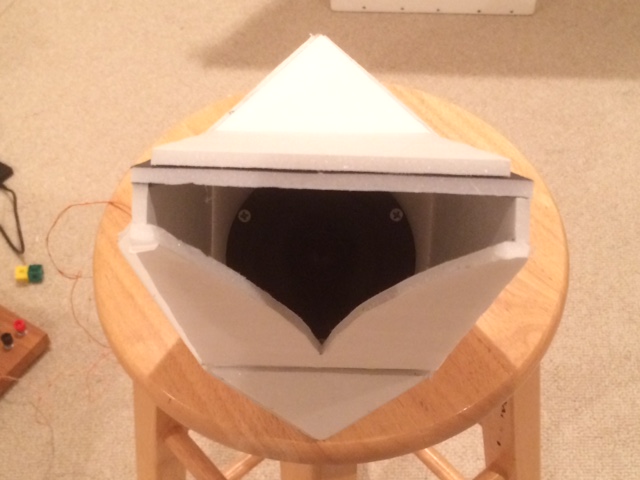
Here are the measurements at various angles with the baseline being the bare RS100-4 at 0 deg. The driver aims up on the Hypercube so once I put the Klam on, I tried a measurement of the mic normal to the driver at same position before I glued the Klam on, and also 0.5m away from the Klam aperture and horizontal. It does add to the midrange, but is peaky (typical of a horn that is not well impedance matched), and falls off steeply after 5kHz:
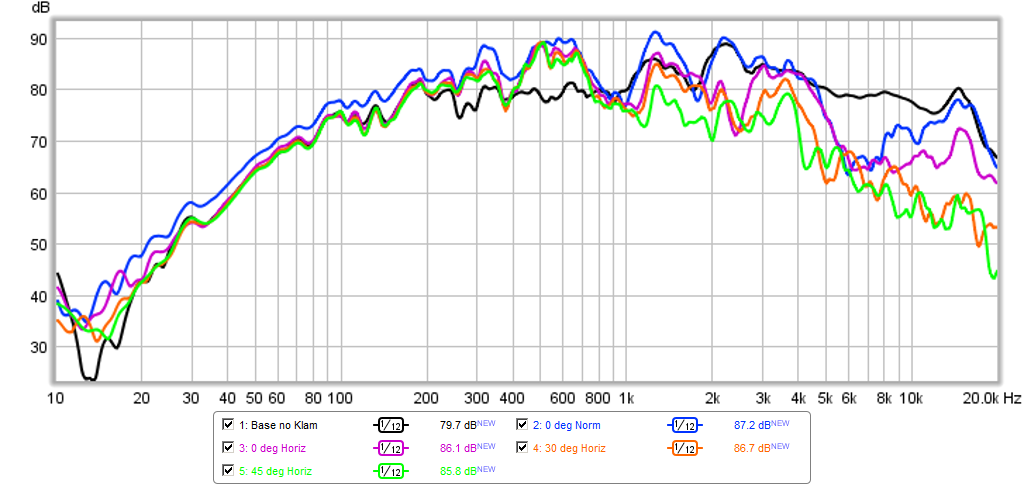
Here is the impulse of the bare RS100-4 in the Hypercube:
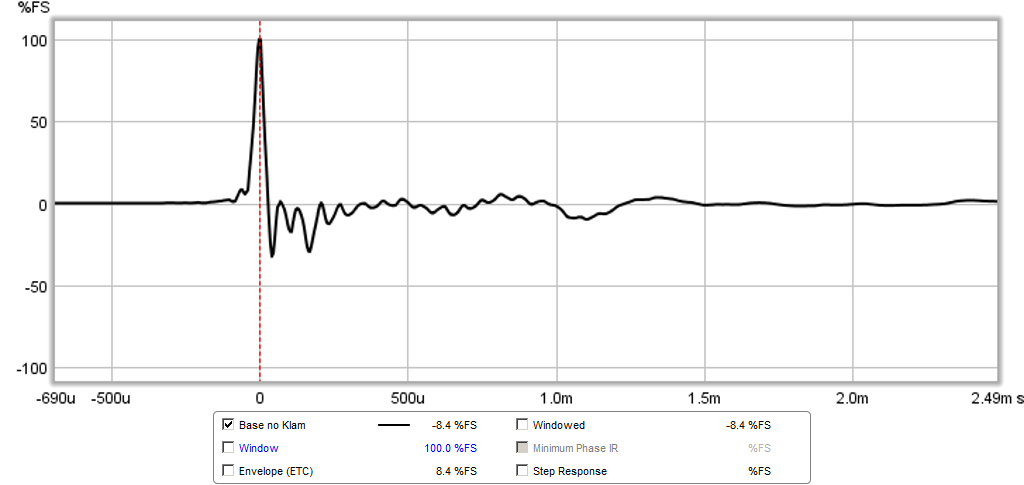
Here is the impulse at normal to driver with the Klam in place:
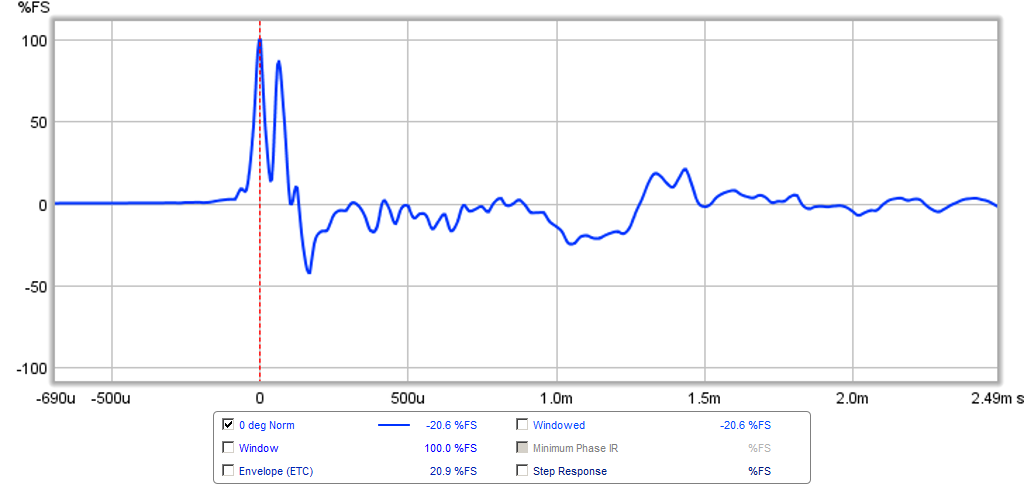
If I move to horizontal, the impulse is a total mess, full of reverberations and echos, delays. This is not the speaker for clean transients:
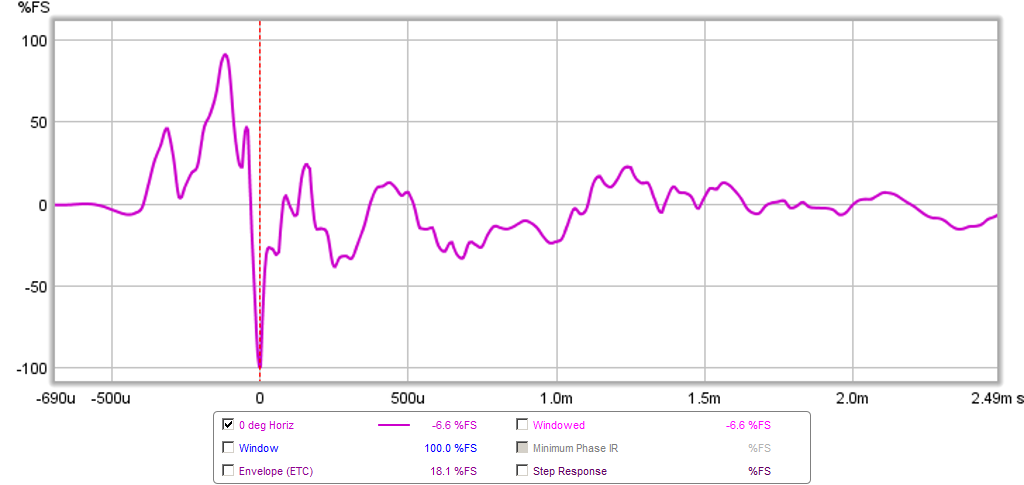
I listened to it and just too much coloration and transient smear - don't like it. Sorry but the Klam is not for me...
Ok Freddi, I built a foam core Klam!
To save time, I tacked it onto an existing Hypercube for the rear sealed chamber. I sort of guessed dimensions and set it based on the Hypercube edge face which is 4.75in wide. So the Klam is 4.75in wide x 4.75in tall x 8.5in long. There is a 0.5in gap at the end of the Klam where the opening is widest. I used CLD on the main flat panel to reduce vibrations and harmonic distortion. I hot melt glued the Klam onto the Hypercube.
Here are some photos of the little Klam, ain't it cute?


Here are the measurements at various angles with the baseline being the bare RS100-4 at 0 deg. The driver aims up on the Hypercube so once I put the Klam on, I tried a measurement of the mic normal to the driver at same position before I glued the Klam on, and also 0.5m away from the Klam aperture and horizontal. It does add to the midrange, but is peaky (typical of a horn that is not well impedance matched), and falls off steeply after 5kHz:

Here is the impulse of the bare RS100-4 in the Hypercube:

Here is the impulse at normal to driver with the Klam in place:

If I move to horizontal, the impulse is a total mess, full of reverberations and echos, delays. This is not the speaker for clean transients:

I listened to it and just too much coloration and transient smear - don't like it. Sorry but the Klam is not for me...
Attachments
-
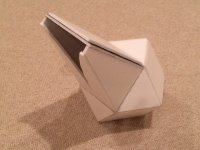 Klam-01.jpg94 KB · Views: 549
Klam-01.jpg94 KB · Views: 549 -
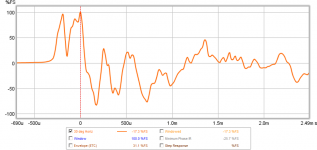 klam-rs100-4-hypercube-ir-30-deg-horiz-with-klam.png61.2 KB · Views: 83
klam-rs100-4-hypercube-ir-30-deg-horiz-with-klam.png61.2 KB · Views: 83 -
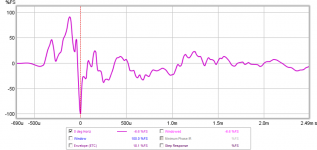 klam-rs100-4-hypercube-ir-0-deg-horiz-with-klam.png55.8 KB · Views: 548
klam-rs100-4-hypercube-ir-0-deg-horiz-with-klam.png55.8 KB · Views: 548 -
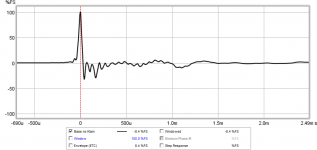 klam-rs100-4-hypercube-ir-0-deg.png41.3 KB · Views: 536
klam-rs100-4-hypercube-ir-0-deg.png41.3 KB · Views: 536 -
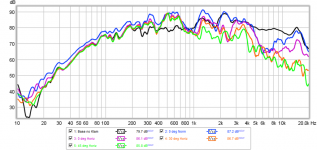 klam-rs100-4-hypercube-polar.png125.1 KB · Views: 537
klam-rs100-4-hypercube-polar.png125.1 KB · Views: 537 -
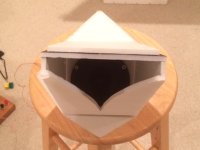 Klam-02.jpg71.3 KB · Views: 557
Klam-02.jpg71.3 KB · Views: 557 -
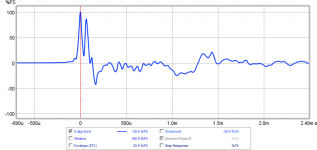 klam-rs100-4-hypercube-ir-0-deg-with-klam.png48.6 KB · Views: 567
klam-rs100-4-hypercube-ir-0-deg-with-klam.png48.6 KB · Views: 567
Last edited:
interesting data and a good try - plus it is "Hyper-Kute" - iirc, some damping material in the back chamber of a klam 8 did some clean-up. The normal position of a klam would be with its top parallel to the floor. There may be some which work better than others - I made a little rough klam for a PA130 which had a bad peak - it was loud. My klam15 is in the region of "ok" and the recent12 maybe better. Some said Karlson's AP9C ceiling speaker for 6x9 fullrange was really nice. BIG THANKS for the experiment ! 😀
with a typical klam, the speaker is buried pretty deep compared to a regular Karlson or Karlsonator
btw, the first model of Karlson's X15 (1965) that has been seen on the internet, had a wood mini klam and 3" fullrange speaker as its tweeter. It was reported that the back chamber was a stryofoam coffee cup.
headphones might give a rough idea of this klam's tone/coloration - it could use a better crossover. The extended K-tube was just jammed down in the little high frequency horn
https://www.youtube.com/watch?v=mupb8X6iZ6I
with a typical klam, the speaker is buried pretty deep compared to a regular Karlson or Karlsonator
btw, the first model of Karlson's X15 (1965) that has been seen on the internet, had a wood mini klam and 3" fullrange speaker as its tweeter. It was reported that the back chamber was a stryofoam coffee cup.
headphones might give a rough idea of this klam's tone/coloration - it could use a better crossover. The extended K-tube was just jammed down in the little high frequency horn
https://www.youtube.com/watch?v=mupb8X6iZ6I
Last edited:
Freddi,
Your Klam sounds nice. Having a 2-way with the K-tube tweeter sticking seems to help with the definition on the highs. It could be that the Klam is more suited for the bass and mids and not good for high frequency for use with a full range. With Karlsonator, more of the driver is visible so a lot of direct radiation is getting out to be useful.
Your Klam sounds nice. Having a 2-way with the K-tube tweeter sticking seems to help with the definition on the highs. It could be that the Klam is more suited for the bass and mids and not good for high frequency for use with a full range. With Karlsonator, more of the driver is visible so a lot of direct radiation is getting out to be useful.
my take on some klam = a higher (midrange) vertical window than horizontal - so one could sit almost under an elevated klam. Its maybe a bit of what you see is what you get as the klam in its normal position is rotated, a couple of deep response notches can appear. I wonder how large a double driver Karlsonator can be built and remain clear sounding?
Alan Weiss who marketed a Klam some years back, used about a 38 degree angle which can keep it short. I would like to hear a Karlson aspect klam made of good plywood. Phase III's particleboard cabinet flexed quite a bit.
my klam12 sounds pretty clear without any K-tube extension of its waveguide. Maybe a klam-10 with Beta10cx based on a 38 degree angle would work well (?)
here's Alan Weiss's klam - it came loaded with either a Radio Shack 8 inch fullrange or the Pioneer BOFU - I should load one with a Beta8cx and compression driver plus use polyfil in the back chamber - IIRC(?), that can lessen some of the artifacts. I think even a BOFU was pretty damn loud 150 feet away from a klam8.

approximate dimensions
Alan Weiss who marketed a Klam some years back, used about a 38 degree angle which can keep it short. I would like to hear a Karlson aspect klam made of good plywood. Phase III's particleboard cabinet flexed quite a bit.
my klam12 sounds pretty clear without any K-tube extension of its waveguide. Maybe a klam-10 with Beta10cx based on a 38 degree angle would work well (?)
here's Alan Weiss's klam - it came loaded with either a Radio Shack 8 inch fullrange or the Pioneer BOFU - I should load one with a Beta8cx and compression driver plus use polyfil in the back chamber - IIRC(?), that can lessen some of the artifacts. I think even a BOFU was pretty damn loud 150 feet away from a klam8.

approximate dimensions
An externally hosted image should be here but it was not working when we last tested it.
Last edited:
one krazy thing to try in some klam with fullrange is to use a "passive" K-tube - it probably could be done with a paper tube. Place the starting end of the tube near the fullrange dustcap/whizzer - just far away enough so it won't get banged on a high spl transient. Make the tube long enough to reach the main aperture plane.
I got someone's old diy 1958 style K12 loaded with a Lafayette SK58 coax - -some of the best midrange I ever heard - a great cone, tiny woofer coil, tiny spider, excellent strong alnico magnet paper cone tweeter - but the chamois surround and little spider had stiffened so much that fs was well above 100Hz. There had to be some very good Karlson and speaker combos back in their day.
I wonder if the Faerber K-tube is 1 inch ID?

I wonder if the Faerber K-tube is 1 inch ID?

Last edited:
Great test, xrk!
Believe it or not, I did the same thing with my hypercubes about a month ago too!
(I wish I had taken some pics 🙄)
I didn't like the sound too much, so I dismantled them quickly.(that's why I didn't take the pics 😀)
But I thought I should give the Klam another chance, and made a pseudo-klam attachment and put it in front of one of my bookshelf speakers. And A-B ed between them.
The highs get 'muffled', sure. But the Karlson aperture does what it does, and although it might not look good on charts and graphs, it was actually pretty good on some instances.
So that experience gave me some hint of potential for using it for bass or midrange. (And that's why I agree with your assessment)
The next step was making a mini foamcore Klam using a 2 inch fullrange driver,
and unlike the cube version, I added some polyfil in the back chamber, which seemed to help the sound.
Two things I am curious about;
1. Since we've seen that the Klam aperture muffles the highs, how did the original Rocket or commercial Klams reach the high frequency claimed on the advertisement? Was there drivers with special parameters?
2. Compared to the original K's, or the K'nator, the Klam's drivers are located deeper, so would getting the aperture's angle more steep help the sound coming out 'untouched'? And if so, would that configuration be so much different from Metro T-15?
Believe it or not, I did the same thing with my hypercubes about a month ago too!
(I wish I had taken some pics 🙄)
I didn't like the sound too much, so I dismantled them quickly.(that's why I didn't take the pics 😀)
But I thought I should give the Klam another chance, and made a pseudo-klam attachment and put it in front of one of my bookshelf speakers. And A-B ed between them.
The highs get 'muffled', sure. But the Karlson aperture does what it does, and although it might not look good on charts and graphs, it was actually pretty good on some instances.
So that experience gave me some hint of potential for using it for bass or midrange. (And that's why I agree with your assessment)
The next step was making a mini foamcore Klam using a 2 inch fullrange driver,
and unlike the cube version, I added some polyfil in the back chamber, which seemed to help the sound.
Two things I am curious about;
1. Since we've seen that the Klam aperture muffles the highs, how did the original Rocket or commercial Klams reach the high frequency claimed on the advertisement? Was there drivers with special parameters?
2. Compared to the original K's, or the K'nator, the Klam's drivers are located deeper, so would getting the aperture's angle more steep help the sound coming out 'untouched'? And if so, would that configuration be so much different from Metro T-15?

I don't think the original Rocket went very high at all. IIRC, it had a 4 inch CTS radio/tv speaker with fs of around 140c.p.s. and a 3 ounce ferrite magnet. Most Karlson and klam benefit from some on-axis rise. Carl Neuser has made Rocket type based on 5" and 6.5" Polk coax. I think they would use a K-tube as follows in my mock-up. btw, there's plenty of highs with my 80oz 12 inch coax in a klam with PRV D280ti compression driver. Its clearer sounding than my BG20 in a fake Druid MLTL and I have no K-tube extension on the coax.
damping material in the rear chamber is probably beneficial to reducing coloration - normally a klam has
a very small back chamber (if sealed - the original Karlson klams all appeared to be vented including the little KR5
Rocket)
a K-tube would be glued to the coaxial dome's flange and extend right to the main aperture plane.
This is a 5 inch Polk coax in the mockup.
Carl's Rockets - I think the klam taper angles are 6 and 12 degrees
The original KR5 Rocket had a really cool finish with blue and gold specks
Carl's klam10 should be pretty good
some years ago I had a spare sheet of plywood so made a klam18 with about a 3 cubic foot sealed rear chamber, qtc probably around 0.85 -imo it had
a better sound in its range than a direct radiator. Starting gap, etc.
have a large effect on the perceived tone and "air" - not a large effect
upon a one mic position response curve. I didn't try any front chamber lining or damping.
maybe some experimenter will hit upon a good aspect and klam angle for a really great klam midrange unit. ( I have a lot of pain so probably won't get it done.)
damping material in the rear chamber is probably beneficial to reducing coloration - normally a klam has
a very small back chamber (if sealed - the original Karlson klams all appeared to be vented including the little KR5
Rocket)
a K-tube would be glued to the coaxial dome's flange and extend right to the main aperture plane.
This is a 5 inch Polk coax in the mockup.
An externally hosted image should be here but it was not working when we last tested it.
Carl's Rockets - I think the klam taper angles are 6 and 12 degrees
An externally hosted image should be here but it was not working when we last tested it.
An externally hosted image should be here but it was not working when we last tested it.
The original KR5 Rocket had a really cool finish with blue and gold specks
An externally hosted image should be here but it was not working when we last tested it.
Carl's klam10 should be pretty good
An externally hosted image should be here but it was not working when we last tested it.
some years ago I had a spare sheet of plywood so made a klam18 with about a 3 cubic foot sealed rear chamber, qtc probably around 0.85 -imo it had
a better sound in its range than a direct radiator. Starting gap, etc.
have a large effect on the perceived tone and "air" - not a large effect
upon a one mic position response curve. I didn't try any front chamber lining or damping.
maybe some experimenter will hit upon a good aspect and klam angle for a really great klam midrange unit. ( I have a lot of pain so probably won't get it done.)
An externally hosted image should be here but it was not working when we last tested it.
Last edited:
we should experiment with shallow cavities and not much angle - FWIW, I liked the effect of a shallow cavity with a Boss 6"x9" fullrange better than a naked driver - on the back of the kontraption, I inverted the slot orientation. Foam core or cardboard would suffice. Some configurations should work/sound better than others.
I agree a shallow chamber similar to a K15 or Karlsonator works well to enhance dispersion without impacting transient response. I think designing a "K15" from scratch for any driver size with suitable TS parameters is as simple as designing a 6th order Bandpass with a K aperture of appropriate cross sectional area. Of course, it is best to have fb above fs of the driver. For moderate Qts driver of 0.45 or 0.5 the fb can probably be tuned below fs but the benefit of low excursion of a K15 won't be valid anymore. I am going to see if my theory proves right with a circa 0.4x scale K15i that has an fb of 60Hz using a 5in driver. Note the "i" designation to distinguish from a plain scaling.
this should be cool and hopefully lead to a simple cookbook recipe for rear and front chambers and tuning.
about a 20 degree angle is the shallowest I've seen for a Karlson. IIRC X15 had its baffle laid back 23 degrees from vertical.
1951 J.E. Karlson "Acoustic Transducers" Patent US2816619 - Acoustic transducers - Google Patents
"If the angle that said inclined plane makes with the plane of said tapered aperture is greatly increased, several effects may be observed. Among these are (1) lower frequency limit (2) increased reverberation time (3) poorer transient response and (4) less uniformity in the radiation pattern throughout the frequency range. Obviously, optimum results for any particular application would be subject to some trial and error tests"
one thing I've not understood about K15 size couplers - although by impedance they may be tuned in the upper 40's, a mic placed at the center of the cone or lower will show a null around 1/2 octave lower than tuning - what would explain that effect? - also , power handling at say 36Hz was much better than a reflex the size of K15's rear chamber with similar tuning (high 40's)
about a 20 degree angle is the shallowest I've seen for a Karlson. IIRC X15 had its baffle laid back 23 degrees from vertical.
1951 J.E. Karlson "Acoustic Transducers" Patent US2816619 - Acoustic transducers - Google Patents
"If the angle that said inclined plane makes with the plane of said tapered aperture is greatly increased, several effects may be observed. Among these are (1) lower frequency limit (2) increased reverberation time (3) poorer transient response and (4) less uniformity in the radiation pattern throughout the frequency range. Obviously, optimum results for any particular application would be subject to some trial and error tests"
one thing I've not understood about K15 size couplers - although by impedance they may be tuned in the upper 40's, a mic placed at the center of the cone or lower will show a null around 1/2 octave lower than tuning - what would explain that effect? - also , power handling at say 36Hz was much better than a reflex the size of K15's rear chamber with similar tuning (high 40's)
Last edited:
Based on Karlson's points above, wouldn't that mean Klams don't work well given the huge angle which leads to reverberation and poor transient response as I observed?
I would think - but some of them do "pretty well" - we're looking at angles of 50-65 degrees - - a one-inch format K-tube, 5.3" long generally plays really nice
you might try a mini-klam 1 for compression driver like the one marketed by Alan Weiss - this was a little surround system sold some years back - the picture came from a link on Job Ulfman's old Karlson forum. The little satellites were sealed boxes with an Eminence Beta8 and Eminence CD8 (type I precursor to PSD-2002) with a sheet metal klam lens. I think the subwoofer was a Karlson with a vent exiting above the aperture.
you might try a mini-klam 1 for compression driver like the one marketed by Alan Weiss - this was a little surround system sold some years back - the picture came from a link on Job Ulfman's old Karlson forum. The little satellites were sealed boxes with an Eminence Beta8 and Eminence CD8 (type I precursor to PSD-2002) with a sheet metal klam lens. I think the subwoofer was a Karlson with a vent exiting above the aperture.
An externally hosted image should be here but it was not working when we last tested it.
Last edited:
if you make the baffle angle shallow with fixed volumes and width, then the resulting enclosure will be taller and may behave different than a more squat aspect. My XK8 box was about the size of a standard K12 but when compared to each other with w8-1772, the regular aspect K had 2 to 5dB more power in the 110 to 220Hz octave.
Ab Initio Karlson KXi
The "i" is for Ab Initio, or from the beginning. I have figured out how to design a new type of "K" box with deep bass, good cone control, for any size driver with appropriate T/S parameters. There is no scaling of the K15 design involved, and it begins with the design of a 6th order bandpass alignment optimized for bass extension, flat response, and good control of cone motion, all properties that a 6th order bandpass alignment is known for. The difference is that the output port is simply a Karlson aperture of appropriate cross sectional area, and the chambers are designed with angles to avoid rectangular volumes that may have resonance modes.
As a test case, I designed a box that can reach 50Hz using a nominal 3.5in driver - the Dayton RS100P-4 (paper cone). This driver has a suitable moderate Qts to allow fb to set below fs and has good xmax of 4mm and a relatively powerful motor. The 6th order bandpass design was a 4.0 liter rear chamber and 1.0 liter front chamber with a 0.5in x 5.0in x 9.0in long vent, and a front chamber vent consisting of a 5in dia aperture.
I converted these volumes and vent dimensions into a box that has internal dimensions of 5in wide x 9.0in tall x 7.5in deep which then provides the correct volumes once the vent volume and driver volumes are subtracted. The front K-aperture is sized to have the same cross sectional area as a 5in dia hole, which was approximated by the area of a triangle that is 5in wide x 7in high, accounting for the curvature and offsets near the bottom.
The box design looks like this:
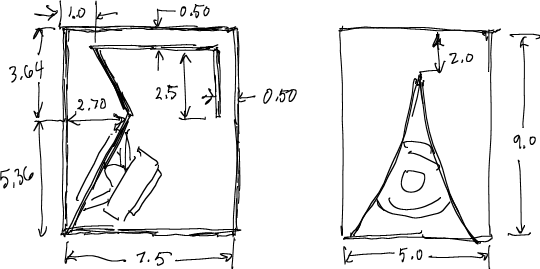
Here is a photo of the inside during construction showing the bracing and folded vent arrangement leading to the top of the front chamber:
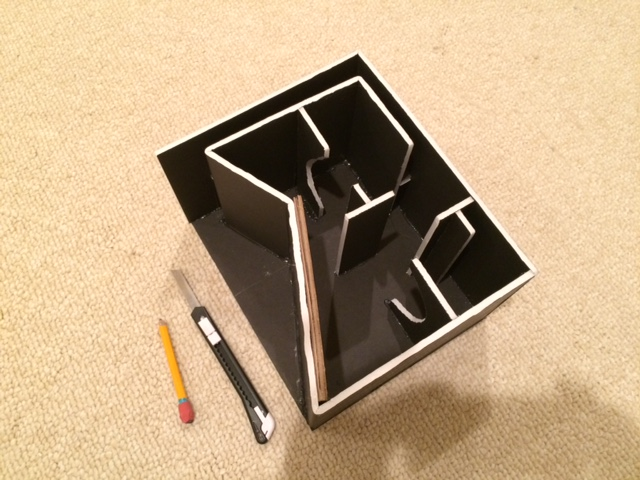
Here is the completed speaker - still retains the look of a very small K15:
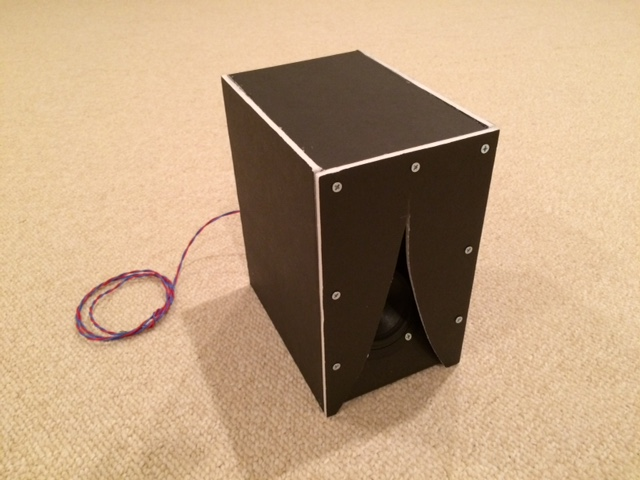
And here is the measured frequency response about 0.5m away along the axis of the driver centerline - it has the characteristic Karlson "W" dips and a falloff near the bandpass followed by the direct radiator output which lets it reach up to the HF limit of the driver (about 14kHz in this case). The measured f3 is 51Hz! An amazing concept for anyone who has ever tried to scale a K15 down will realize. Predicted max SPL at 4mm xmax is 98dB in 2pi space:
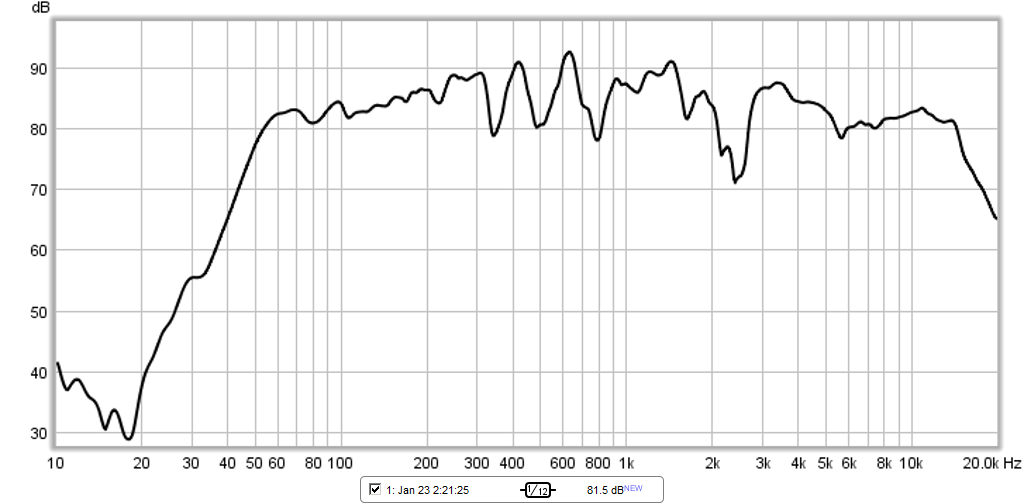
How does it sound? I got to listen to 1 minute of 1 test track and it sounds very nice. Did not audibly notice the dips. Dispersion was very good and transients were clean (the impulse response was clean and I will show that later). So I think I have finally cracked to code on how to make a very small "Karlson" that has good bass extension and transient dynamics. At 5in wide x 9in tall x 7.5in deep, it is a pretty small speaker - suitable for desktop or bookshelf use. With an f3 of 51Hz, it is pretty impressive.
Now, the neat thing about this methodology is that if a 3.5in driver can hit 51Hz, a 6.5in or 8in can probably do 40Hz. This can also be used for a sub woofer with a good pro audio 12in driver like the Faital Pro 12HP1030 and achieve 120dB SPL and mid 30Hz...
The "i" is for Ab Initio, or from the beginning. I have figured out how to design a new type of "K" box with deep bass, good cone control, for any size driver with appropriate T/S parameters. There is no scaling of the K15 design involved, and it begins with the design of a 6th order bandpass alignment optimized for bass extension, flat response, and good control of cone motion, all properties that a 6th order bandpass alignment is known for. The difference is that the output port is simply a Karlson aperture of appropriate cross sectional area, and the chambers are designed with angles to avoid rectangular volumes that may have resonance modes.
As a test case, I designed a box that can reach 50Hz using a nominal 3.5in driver - the Dayton RS100P-4 (paper cone). This driver has a suitable moderate Qts to allow fb to set below fs and has good xmax of 4mm and a relatively powerful motor. The 6th order bandpass design was a 4.0 liter rear chamber and 1.0 liter front chamber with a 0.5in x 5.0in x 9.0in long vent, and a front chamber vent consisting of a 5in dia aperture.
I converted these volumes and vent dimensions into a box that has internal dimensions of 5in wide x 9.0in tall x 7.5in deep which then provides the correct volumes once the vent volume and driver volumes are subtracted. The front K-aperture is sized to have the same cross sectional area as a 5in dia hole, which was approximated by the area of a triangle that is 5in wide x 7in high, accounting for the curvature and offsets near the bottom.
The box design looks like this:

Here is a photo of the inside during construction showing the bracing and folded vent arrangement leading to the top of the front chamber:

Here is the completed speaker - still retains the look of a very small K15:

And here is the measured frequency response about 0.5m away along the axis of the driver centerline - it has the characteristic Karlson "W" dips and a falloff near the bandpass followed by the direct radiator output which lets it reach up to the HF limit of the driver (about 14kHz in this case). The measured f3 is 51Hz! An amazing concept for anyone who has ever tried to scale a K15 down will realize. Predicted max SPL at 4mm xmax is 98dB in 2pi space:

How does it sound? I got to listen to 1 minute of 1 test track and it sounds very nice. Did not audibly notice the dips. Dispersion was very good and transients were clean (the impulse response was clean and I will show that later). So I think I have finally cracked to code on how to make a very small "Karlson" that has good bass extension and transient dynamics. At 5in wide x 9in tall x 7.5in deep, it is a pretty small speaker - suitable for desktop or bookshelf use. With an f3 of 51Hz, it is pretty impressive.
Now, the neat thing about this methodology is that if a 3.5in driver can hit 51Hz, a 6.5in or 8in can probably do 40Hz. This can also be used for a sub woofer with a good pro audio 12in driver like the Faital Pro 12HP1030 and achieve 120dB SPL and mid 30Hz...
Attachments
Last edited:
- Home
- Loudspeakers
- Full Range
- A Speaker that Kicks Butt in Large Spaces
